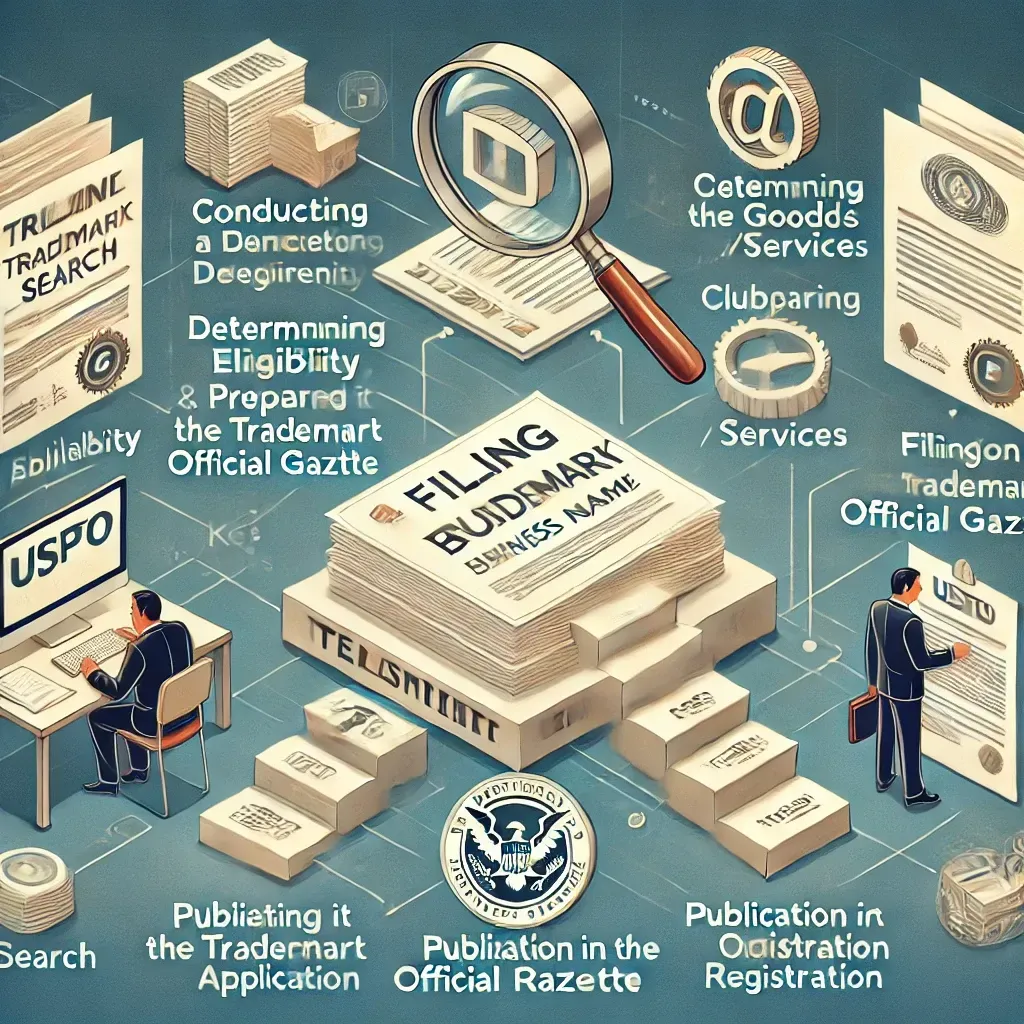The Step-by-Step Process of Filing a Trademark for Your Business Name
Protecting your business name through trademark registration is a crucial step in safeguarding your brand identity. At Masterly Trademarks, we guide you through the trademark registration process to ensure your business name is legally protected.
Understanding Trademarks and Their Importance
A trademark is a distinguishing mark that identifies and sets one party's goods or services apart from those of other parties. Examples of these signs include words, phrases, symbols, and designs. By registering your company name as a trademark, you give yourself the sole right to use it in relation to your products or services, providing legal defense against unapproved use by third parties.
Step 1: Conduct a Comprehensive Trademark Search
It's crucial to perform a comprehensive search before submitting a trademark application to make sure your preferred company name isn't already in use or too close to an existing trademark. This involves:
- Searching the United States Patent and Trademark Office (USPTO) database for existing trademarks.
- Checking state trademark databases and business name registrations.
- Reviewing domain names and internet searches to identify unregistered but used trademarks.
A comprehensive search helps prevent potential legal trouble and increases the likelihood of a successful trademark registration.
Step 2: Determine the Eligibility of Your Business Name
Not all business names are eligible for trademark protection. To qualify, your name must be distinctive and not merely descriptive or generic. Trademarks are categorized as:
- Fanciful: Invented words with no dictionary meaning (e.g., Exxon®).
- Arbitrary: Common words used in an unrelated context (e.g., Apple® for computers).
- Suggestive: Names that hint at a characteristic of the goods or services (e.g., Coppertone® for sunscreen).
Descriptive or generic names are generally not eligible for trademark protection unless they have acquired distinctiveness through extensive use.
Step 3: Identify the Goods or Services Associated with Your Trademark
Clearly define the goods or services your business offers and classify them according to the international Nice Classification system, which categorizes goods and services into 45 classes. Accurate classification is crucial, as it determines the scope of your trademark protection.
Step 4: Prepare Your Trademark Application
Gather all necessary information and documents for your application, including:
- The exact representation of your business name (standard character mark or stylized/design format).
- A detailed description of the goods or services associated with the trademark.
- The appropriate classification of these goods or services.
- The basis for filing: use in commerce (if your business name is already in use) or intent to use (if you plan to use it in the near future).
Step 5: File Your Trademark Application with the USPTO
Submit your application electronically through the USPTO's Trademark Electronic Application System (TEAS). Choose between:
- TEAS Plus: Lower filing fee but requires stricter adherence to USPTO guidelines.
- TEAS Standard: Higher filing fee with more flexibility in describing your goods or services.
Ensure all information is accurate and complete to avoid delays or refusals.
Step 6: Monitor Your Application Status
Your application will be given to an examining attorney upon submission, who will check it for legal conformity. The attorney may issue an office action if there are any issues, such as:
- Likelihood of confusion with an existing trademark.
- Descriptiveness or genericness of the business name.
- Incomplete or inaccurate information.
Respond promptly to any office actions to keep your application moving forward.
Step 7: Publication in the Trademark Official Gazette
If the examining attorney approves your application, it will be published in the USPTO's Trademark Official Gazette. This publication opens a 30-day window for third parties to oppose your trademark registration if they believe it would harm their existing trademark rights.
Step 8: Final Registration and Maintenance
If no oppositions are filed, or if any oppositions are resolved in your favor, the USPTO will issue a registration certificate, officially granting you trademark rights to your business name. To maintain your trademark registration:
- File a Declaration of Use between the fifth and sixth year after registration.
- Renew your trademark every ten years.
Failure to meet these requirements can result in the cancellation of your trademark.

Benefits of Trademark Registration
Registering your business name as a trademark offers several advantages:
- Exclusive Rights: Legal ownership and exclusive rights to use the trademark nationwide.
- Legal Protection: Ability to take legal action against unauthorized use or trademark infringement.
- Brand Recognition: Establishes your brand identity, building trust and recognition among consumers.
- Asset Value: Enhances the value of your business, making it a more valuable asset.
Common Challenges in the Trademark Registration Process
The trademark registration process can present several challenges, including:
- Identifying the Correct Goods and Services: Accurately defining and classifying your offerings.
- Existing Trademarks: Potential conflicts with similar existing trademarks.
- Office Actions: Responding to issues raised by the examining attorney.
Seeking legal assistance from a trademark attorney can help navigate these challenges effectively.
The Step-by-Step Process of Filing a Trademark for Your Business Name
Filing a trademark business name is essential for protecting your brand identity and ensuring no other business entity can use the same name. The trademarking process begins with a thorough search to check for a similar mark that might lead to rejection. Once the application process starts, the United States Patent and Trademark Office (USPTO) assigns an examining attorney to review the completed application. If the examining attorney raises any concerns, such as conflicts with existing trademark owners, your application may face delays or even opposition.
The entire registration process can also involve legal proceedings, including a trademark trial before the appeal board if disputes arise. Some cases may escalate to federal court, where legal rights and legal grounds are evaluated. Additionally, small businesses should be mindful of the required fees and the filing basis they choose when submitting their applications filed. If your business operates internationally, pursuing foreign registration may be necessary.
Protecting a trademarked name also involves understanding whether your mark qualifies as a trade name or a service mark, as these designations impact your rights under trademark law. If you are using a fictitious name, additional steps may be required to establish trademark use. By following the entire process carefully, small businesses can secure their brand identity and gain a competitive edge in the market.
How to Register a Trademark and Protect Your Business Name
When you register a trademark, you gain exclusive rights to your brand name, ensuring that no other entity can use it in a way that could cause confusion. The process begins by submitting your applications submitted to the United States Patent and Trademark Office (USPTO). If approved, your trademark receives federal registration, granting protection at the federal level, which is a powerful tool for safeguarding your brand. This protection is particularly important for businesses that sell goods or offer services across state lines.
Once your application is reviewed, it typically takes several business days before you receive initial feedback from an examining attorney. If any issues arise, you may need to pay an additional fee to address objections or make necessary modifications. Properly filing for federal registration not only strengthens your legal standing but also gives you the ability to enforce your rights against infringers, helping you maintain control over your brand identity in the marketplace.
Why Trademarking Your Business Name Matters for Legal Protection
When choosing a name for your business entity, it’s essential to ensure that no other company is using the same name in a way that could lead to legal disputes. If another company claims ownership of a similar or identical trademark, you may face legal action, which could result in costly rebranding efforts or even losing the right to operate under your chosen name.
By securing a trademark, you gain exclusive rights to your business name and reduce the risk of conflicts with competitors. If a dispute arises, having a registered trademark strengthens your position in enforcing your rights and taking legal action against infringers. Protecting your brand through trademark registration ensures long-term stability for your business entity and helps build a strong, recognizable identity in your industry.
The Trademarking Process: Securing Your Trademarked Name for Long-Term Protection
The trademarking process is essential for any business looking to protect its brand identity and prevent competitors from using a trademarked name that is too similar. This process begins with conducting a trademark search to ensure your desired name is available, followed by submitting a formal application to the United States Patent and Trademark Office (USPTO).
Once the application is submitted, the trademarking process involves an examination by a USPTO attorney who may raise objections if the name conflicts with existing trademarks. If no issues arise, the mark moves to a public opposition period before final approval. Registering a trademarked name gives businesses exclusive rights, allowing them to take legal action against potential infringers. Successfully navigating the trademarking process helps businesses establish a strong, legally protected brand that can grow without the risk of disputes.
How Trademarking Protects Your Brand and Domain Names
Securing a trademark doesn’t just protect your business name—it also helps safeguard your domain names from potential misuse. In today’s digital landscape, businesses rely heavily on their online presence, making it crucial to ensure that domain names align with their brand identity. A registered trademark strengthens your ability to prevent others from using similar domain names that could confuse customers or mislead potential clients.
During the trademarking process, businesses should check the availability of domain names that match their brand to avoid conflicts. If another party registers a similar domain, having a trademarked name can give you legal standing to claim ownership or dispute unauthorized use. As part of brand protection, businesses should secure relevant domain names early to establish a strong online identity and prevent cybersquatting issues in the future.
Navigating the Trademark Application Process: Key Steps for Business Owners
Filing a trademark application is a crucial step in protecting your brand and ensuring exclusive rights to your business name or logo. The trademark application process begins with a comprehensive search to confirm that no existing marks conflict with your desired name. Once confirmed, you must prepare and submit a trademark application to the United States Patent and Trademark Office (USPTO), providing details about your business, the goods or services associated with the mark, and the appropriate classification.
After submission, the trademark application undergoes examination by a USPTO attorney, who will review it for conflicts, accuracy, and compliance with trademark laws. If no objections arise, the trademark application moves to a public opposition period, allowing third parties to challenge the registration. Successfully completing the trademark application grants businesses long-term legal protection, preventing competitors from using a similar mark and strengthening brand identity in the marketplace.
How to Trademark a Business Name: A Step-by-Step Guide
Understanding how to trademark a business name is essential for protecting your brand and preventing others from using a similar name. The process begins with a comprehensive search to ensure your desired name is not already in use or too similar to an existing trademark. Once confirmed, you must file a trademark application with the United States Patent and Trademark Office (USPTO), providing details about your business and the goods or services associated with the name.
After submission, the USPTO assigns an examining attorney to review your application. If approved, the name moves to a public opposition period, where third parties can challenge the registration. Once the process is complete, you gain exclusive rights to your trademarked name, allowing you to enforce your brand’s legal protection and build long-term recognition in your industry.
The Role of Trademark Consultancy Services in Protecting Your Business Name
Navigating the trademark registration process can be complex, which is why many businesses turn to trademark consultancy services for expert guidance. These services help business owners conduct thorough trademark searches, prepare applications, and respond to any legal challenges that may arise during the registration process. By working with professionals, you can ensure that your business name is properly protected and avoid costly legal disputes.
Trademark consultancy services also assist in enforcing trademark rights, monitoring potential infringements, and handling renewals to maintain your trademark's validity. Whether you’re registering a new trademarked name or managing an existing portfolio, these services provide valuable expertise to safeguard your brand at both the national and international levels.
Secure Your Business Name with Expert Trademark Guidance
Navigating the trademark registration process can be complex. At Masterly Trademarks, we specialize in helping businesses protect their brand identities. Contact us at (972) 236-5051 to book a free consultation. Our experienced trademark attorneys are ready to answer any questions you have and guide you through the process of securing your business name.
Note: This article is for informational purposes only and does not constitute legal advice. For specific legal concerns, consult with a qualified trademark attorney.
You might also like



